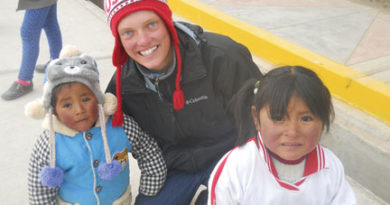Kids Count tracks kids
Voices for Children in Nebraska releases 2011 child well-being report – emphasis on disadvantages of the poor
Kids Count, a national and state-by-state effort to track the status of children in the United States measures educational, social, economic and physical well-being of children each year. Kids Count in Nebraska, like other states in conjunction with the national group, documents and reports the number of cases in the state involving child abuse and neglect, early care and education, juvenile arrests, out of home care and adoption.
In its 2011 report released Jan. 12, 2012, Voices For Children in Nebraska shared in its “Kids Count in Nebraska” report, statistical data for the state as a whole and each of Nebraska’s 93 counties. With this year’s emphasis on the need to invest in young children, particularly those ages 0 to 8 years, the report continues to provide pertinent information on the well-being of all children in areas of health, education, safety and economic stability; a message Voices for Children took to state legislators earlier this month.
Children do not choose the family, the geographic location, or the circumstances into which they are born, notes the Voices for Children group in its annual report. Yet their first eight years of life strongly influence their ability to achieve in school, to pursue advanced education, to be gainfully employed, and to contribute to society. A successful adulthood can often be predicted as early as the end of third grade, the time when children make the switch from learning to read, to reading to learn. When children miss that bench mark, the report states, they are at increased risk of dropping out – leaving them with lowered personal incomes.
Children of low income families lag behind their more economically stable peers, even before they are born, states the report. They hear fewer words, have fewer developmentally stimulating experiences, suffer poorer nutrition, child care and health care.
According to new research, achievement gaps are revealed before school begins – disparities begin at birth – and can be dramatically influenced by prematurity and birth weight. The disparities increase as the child ages.
Nebraska fourth-grade reading achievement tests tend to substantiate the report’s claims. Among low-income fourth-graders, 43 percent failed to meet basic reading requirements, compared to six percent from economically sound families. And 12 percent of higher income fourth-graders earned advanced scores for achievement compared to only three percent of poor children.
According to the report, Nebraska spends less and offers less to its youngest, poorest and most vulnerable children. The state ranks 39th in funding early childhood education.
In Thayer County (figures are taken from 2010) there are 1,220 children under the age of 19; 304 under the age of five. Nearly 18 percent of those children are poor. Four babies had low birth weights.
Nine families in the county are on ADC, while 111 children participate in the food stamp program; 84 participate in the WIC program. There are 228 students enrolled in the free/reduced school lunch program.
In 2010, there were 45 births in Thayer County; eight to mothers under the age of 18.
Educationally, 162 students were enrolled in special education, while 17 were enrolled in Head Start.
While children raised in poverty suffer disadvantages their economically sound peers do not, solutions to address these issues do exist, states the report. Providing children with good health care, a quality education, a safe environment and economic stability allows kids to focus on what they do best – learn and grow.
Kids Count in Nebraska is used as a resource across the state by government agencies, media outlets, educators, child welfare organizations and concerned citizens.



